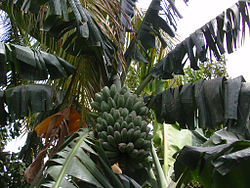- Saba banana
-
Musa 'Saba' 
Saba bananas typically grow to very large sizes.Details Hybrid parentage Musa acuminata × Musa balbisiana Cultivar group ABB Group Cultivar 'Saba' Origin Philippines Saba banana, also known as Cardaba banana, is a triploid hybrid banana cultivar originating from the Philippines. It is primarily a cooking banana though it can also be eaten raw. It is one of the most important banana varieties in Philippine cuisine.
Contents
Description
Saba bananas have very large, robust pseudostems that can reach heights of 20–30 feet (6–9 m). The trunk can reach diameters of 3 feet. The trunk and leaves are dark blue-green in color. Like all bananas, each pseudostem flowers and bears fruits only once before dying. Each mat bears about eight suckers.[1][2][3]
The fruits become ready for harvesting 150 to 180 days after flowering, longer than other banana varieties. Each plant has a potential yield of 26 to 28 kg per bunch. There are typically 16 hands per bunch, with each hand having 12 to 20 fingers.[3]
Saba bananas grow best in well-drained fertile soils with full sun exposure. They inherit most of the characteristics of Musa balbasiana, making them tolerant of dry soil and colder conditions of temperate climates. They require minimum rainfall and can survive long dry seasons as long as adequate irrigation is provided. However, their fruits may not ripen under such conditions. They also have good resistance against Sigatoka leaf spot diseases.[2]
The fruits are 8 to 13 cm long and 2.5 to 5.5 cm in diameter. Depending on the ripeness, the fruits are distinctively squarish and angular. The flesh is white and starchy, making it ideal for cooking. They are usually harvested while still green after 150 to 180 days after planting, especially if they are to be transported over long distances.[3]
Taxonomy and nomenclature
The Saba Banana is a triploid (ABB) hybrid of the seeded banana Musa balbisiana and Musa acuminata.[1]
Its official designation is Musa acuminata × balbisiana Colla (ABB Group) cv. 'Saba'.
Synonyms include:
- Musa × paradisiaca L. cultigroup Plantain cv. 'Saba'
- Musa sapientum L. var. compressa (Blanco) N.G.Teodoro
Saba is known in English as Saba, Cardaba, Sweet plantain, Compact banana, and Papaya banana. Saba is also known by other common names like the following:
- Javanese (Bali): Biu gedang saba
- Malaysian: Pisang Nepah
- Indonesian: Pisang Kepok
- Thai: Kluai Hin
- Hawaiian: Opu-’ulu, Dippig[4]
Wild triploid Musa balbisiana bananas (Musa balbisiana Colla (BBB Group) cv. 'Cardaba') are also called 'Cardaba' in the Philippines.[1]
Uses
Saba bananas are one of the most important bananas in the Philippines.[5] The fruits provide the same nutritional value as potatoes.[3] They can be eaten raw or cooked into various traditional Filipino desserts and dishes like Maruya, Turrón, Halo-halo and Ginanggang. It is also popular in Indonesia, Malaysia, and Singapore in dishes like Pisang Aroma (similar to the Filipino Turrón) and Pisang goreng (fried bananas).
Saba is also processed into a Filipino condiment known as Banana ketchup, invented by the Filipino food technologist and war heroine Maria Y. Orosa (1893–1945). The dark red inflorescence of Saba (banana hearts, locally known in the Philippines as "Puso ng Saba") are edible. The waxy, green leaves are also used as traditional wrappings of native dishes in Southeast Asia. Fibers can also be taken from the trunk and leaves and used to manufacture ropes, mats, and sacks.
Saba bananas are also cultivated as ornamental plants and shade trees for their large size and showy coloration.
Pests and diseases
Common pests
- Fruit scarring beetles
- Banana thrips
- Mealy bug
- Banana aphids
- Corm weevil
- Borers
- Root Nematodes
- Grasshoppers
Common diseases
- Panama disease/Fusarium Wilt
- Sigatoka
- Moko or Bacterial Wilt
- Black leaf streak
- Banana Bunchy Top disease
See also
- Banana
- Banana Cultivar Groups
- Banana ketchup
- Musa balbisiana
- Musa acuminata
- Plantain
References
- ^ a b c "PlantFiles: Saba Banana, Papaya Banana, Pawpaw Banana". http://davesgarden.com. http://davesgarden.com/guides/pf/go/73739/. Retrieved 11 January 2011.
- ^ a b "Musa Saba". http://www.bananas.org/. http://www.bananas.org/wiki/Musa_Saba. Retrieved 11 January 2011.
- ^ a b c d Dr. Biley E. Temanel (16 December 2007). "Techno-Guide for Saba Banana Production in Cagayan Valley". http://www.openacademy.ph. http://www.openacademy.ph/index.php?option=com_content&task=view&id=1089&Itemid=381. Retrieved 11 January 2011.
- ^ Koon-Hui Wang, Angela K. Kepler, & Cerruti R.R. Hooks. Brief Description of Banana Cultivars Available from the University of Hawaii Seed Program. College of Tropical Agriculture and Human Resources, University of Hawai'i at Manoa. http://www.ctahr.hawaii.edu/sustainag/Downloads/Description_of_banana_available_at_ADSC.pdf. Retrieved June 29, 2011.
- ^ Hautea, D.M., G.C. Molina, C.H. Balatero, N.B. Coronado, E.B. Perez, M.T.H. Alvarez, A.O. Canama, R.H. Akuba, R.B. Quilloy, R.B. Frankie, C.S. Caspillo (19/07/2002). "Analysis of induced mutants of Philippine bananas with molecular markers". Institute of Plant Breeding, College of Agriculture, University of the Philippines Los Baños, FAO Coporate Document Repository. http://www.fao.org/docrep/007/ae216e/ae216e07.htm. Retrieved 12 January 2011.
Bananas and Plantains Cultivars Blue Java · Cavendish · Goldfinger · Grand Nain · Gros Michel · Lady Finger · Lacatan · Latundan · Pisang Awak · Plantain · Red · Rhino Horn · Saba · SeñoritaCultivar groups AA group · AAA group (Cavendish group) · AAA-EA subgroup (East African Highland bananas) · AAAA group · AAAB group · AAA group (Plantain group) · AABB group · AB group · ABB group · ABBB group · BB Group · BBB Group
Culinary usage Banana beer · Banana bread · Banana chips · Banana cue · Bananas Foster · Banana fritter · Banana ketchup · Banana powder · Banana pudding · Banana sauce · Banana split · Banana wine · Banania · Bánh chuối · Frozen banana · Ginanggang · Matoke · Maruya · Pisang goreng · Tonto · Turrón
Related topics Categories:- Banana cultivars
Wikimedia Foundation. 2010.



